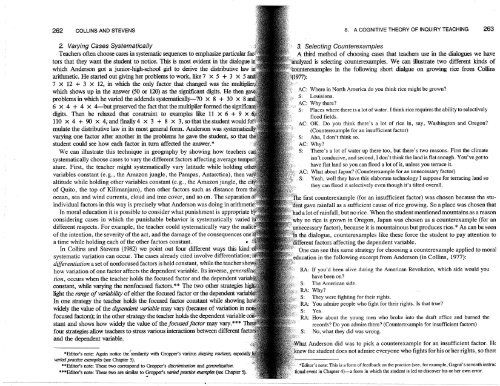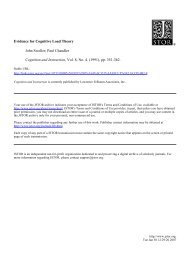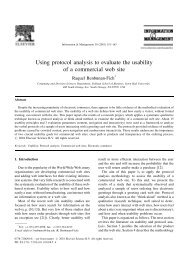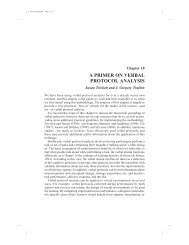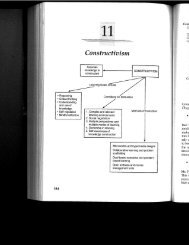Cognitive Theory of Inquiry Teaching-Collins - Ammon Wiemers ...
Cognitive Theory of Inquiry Teaching-Collins - Ammon Wiemers ...
Cognitive Theory of Inquiry Teaching-Collins - Ammon Wiemers ...
Create successful ePaper yourself
Turn your PDF publications into a flip-book with our unique Google optimized e-Paper software.
262 COLLINS AND STEVENS2. Varying Cases SystematicallyTeachers <strong>of</strong>ten choose cases in systematic sequences to emphasize particulartors that they want the student to notice. This is most evident in the dialogue iwhich Anderson got a junior-high-school girl to derive the distributive law inarithmetic. He started out giving her problems to work, like 7 X 5 + 3 x 57 x 12 + 3 x 12, in which the only factor that changed was thewhich shows up in the ¿rnswer (50 or 12,0) as the significant digits. He thenproblems in which he varied the addends systematically-7O x 8 + 30 x 86 x 4 + 4 x 4-butpreservedthefactthatthemultiplierformedthedigits. Then he relaxed that corstraint to examples like ll x 6 + 9 x110 x 4 + 90 x 4;andfinally4 x 3 + 8 x 3,sothatthestudentwouldmulate the distributive law in its most general form. Anderson was systemativarying one factor after another in the problems he gave the student, so thatstudent could see how e¿ch factor in tum affected the answer.*We can illustrate this technique in geography by showing how teacherssystematically choose cases to vary the different factors affecting average temature. First, the teacher might systematically vary latitude while holdingvariables constant (e.g., the Amazon jungle, the Pampas, Antarctica), then valtitude while holding other variables constant (e.g., the Amazon jungle, the ci<strong>of</strong> Quito, the top <strong>of</strong> Kilimanjaro), then other factors such as distance fromocean, sea and wind currents, cloud and tree cover, and so on. The separationindividual factors in this way is precisely what Anderson was doing in ariIn moral education it is possible to consider what punishment is appropriatelconsidering cases in which the punishable behavior is systematically varied'different respects. For example, the teacher could systematically vary the<strong>of</strong>the intention, the severity <strong>of</strong>the act, and the damage <strong>of</strong>the consequences onea time while holdine each <strong>of</strong> the other factors constant.rIn <strong>Collins</strong> and Stevens (1982) we point out four different ways this kindsystematic variation can occur. The cases already cited involve differentiation;dffirentiation a set <strong>of</strong> nonfocused factors is held constant, while the teacherhow variation <strong>of</strong> one factor affects the dependent variable . Its inverse, genetíon, occurs when the teacher holds the focused factor and the dependent vconstånt, while varying the nonfocused factors.** The two other strategieslight the range <strong>of</strong> variability <strong>of</strong> either the focused factor or the dependent variaIn one strategy the teacher holds the focused factor constant while showingwidely the value <strong>of</strong> the dependent variable may vary (because <strong>of</strong> variation infocused factors); in the other strategy the teacher holds the dependent variablestant and shows how widely the value <strong>of</strong> the foatsed factor may vary.*four strategies allow teachers to stress various interactions between different fand the dependent variable.*Editor's note: Again notice the similarity wittr Gropper's vanous shaping routines, especiallyvaríd practice øømplæ (see Chapter 5).+*Editor's note: These two correspond to Gropper's discrimination and generalization.***Editor's note: These hÀ'o are similar to Groppø's varid practiæ øtamplæ (see Chapter Ð.8. A COGNITIVE THEORY OF INOUIRY TEACHING 2633, Selecting CounterexamplesA third method <strong>of</strong> choosing cases that teachers use in the dialogues we haveis selecting counterexarnples. We can illustrate two different kinds <strong>of</strong>'r"munterexamples in the following short dialgue on growing rice from <strong>Collins</strong>,,:(1977):Where in North America do you think rice might be grown?Louisiana.Why there?Places where there is a lot <strong>of</strong> water. I think rice requires the ability to selectivelyflood fields.OK. Do you think there's a lot <strong>of</strong> rice in, say, Washington and Oregon?(Counterexample for an insufficient factor)S: Aha, I don't think so.AC: whv?S: There's a lot <strong>of</strong> water up there too, but there's two reasons. First the climateisn't conducive, and second, I don't think the land is flat enough. You've got tohave flat land so you can flood a lot <strong>of</strong> it, unless you terrace it.C: What about Japan? (Counterexample for an unnecessary factor)Yeah, well they have this elaborate technology I suppose for terracing land sothey can flood it selectively even though it's tilted overallfirstcounterexample (for an insufficient factor) was chosen because the stuäèntgave rainfall as a sufficient cause <strong>of</strong>rice growing. So a place was chosen thal'had a lot <strong>of</strong> rainfall, but no rice. When the student mentioned mountains as a reason.why no riçe is grown in Oregon, Japan was chosen as a counterexample (for antunnecessary factor), because it is mountainous butproduces rice.* As can be seeni.in the dialogue, counterexamples like these force the student to pay attention toldifferent factors affecting the dependent variable.' 'One can see this same strategy for choosing a counterexample applied to moraleducation in the following excerpt from Anderson (in <strong>Collins</strong>, 1977):RA: If you'd been alive during the American Revolution, which side would youhave been on?S: The American side.RA: Why?S: They were fighting for their rights.RA: You admire people who fight for their rights. Is that true?S: Yes.RA: How about the young men who broke into the draft <strong>of</strong>fice and burned therecords? Do you admire them? (Counterexample for insufficient factors)S: No, what they did was wrong.":lVhat Anderson did was to pick a counterexample for an insufficient factor. Ht,,.rknew the student does not admire everyone who fights for his or her rights, so then'xEditor'snote:Thisisaform<strong>of</strong>feedbackonthepractice(see,forexample,Gagné'sseventhinstru(tional event in Chapter 4)-a form in which the student is led to discover his or her own enor.


